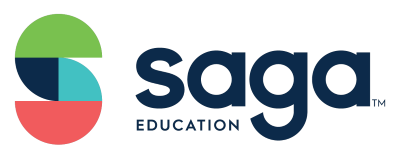Saga Education sat down with Lindsay Lopez, an AmeriCorps member in Broward County (FL), to talk about what it’s really like to serve with Saga.
Why did you want to be an AmeriCorps member with Saga Education?
I was drawn to Saga’s mission of helping underserved students succeed academically, because there is inequity throughout the education system. Saga provides tools and technology never before used in a classroom setting that give these students a chance to succeed academically and emotionally.
A lot of students that I knew struggled in the last two years due to COVID, and had challenges with remote education. I was able to adapt to online platforms and strive in my classes. Serving for Saga allows me to give back to students and use technology in positive ways to enhance learning.
What’s a typical day like?
A day in the life as an AmeriCorps member is truly what you make of it. Saga offers both in person and online service programs, which makes it unique. I serve students online in Broward County, tutoring the same students throughout their school day through Saga’s online classroom, Saga Connect.
This is a full time service and gap year opportunity. My typical day starts with my alarm going off at 6:30 am every Monday through Friday. I have to admit, I hit snooze a few times before I get up! My supervisor calls us “The A Team” because she takes pride in how well our team collaborates and communicates with each other to best serve our students. We are like a puzzle, each of us our own piece, that makes the picture whole. We identify our strengths to create unique lessons for our students that cater to their interests and needs. The A Team starts their day by expressing our Saga pride and wearing our Saga T-shirts or pins. Today was chilly so I opted to wear my fuzzy pajama pants to work. This is one of the perks of being a remote!
How do you prepare for the day?
At 7:20 am, The A Team joins Zoom to discuss today’s activities and continue working on professional duties to prepare for class. After getting ready, I will usually spend 45 minutes making any touch-ups to my lesson plans, checking my email or calendar, and preparing my notes for the day.
When does the day begin?
Class begins around 7:40 with the start of the morning bell. I log into Saga Connect, where I meet in small groups of two or three students. Each class is split into two sessions that last 45 minutes. I alternate between two schools every other day and tutor about thirty students in total. We have one planning period and a 30-minute lunch break. Another perk of this job is I never forget to bring my lunch.
How do you develop relationships with the students?
We start class with an icebreaker, such as, “what are your future career goals?” I ask these questions to get to know my students. I learn about my student’s wants, needs and interests in order to give them the tools they deserve to be successful in life. We review skills they are learning in their regular algebra class by creating a virtual, interactive lesson space. The class continues with a “do now” question, a critical thinking task, practice problems, and a ticket to leave. The “do now” question and ticket to leave are mini quizzes we give in the beginning and end of class to measure student comprehension. We also design our lessons to cater to social and emotional goals, such as having students talk about their answers or explain their thinking processes.
What are some of the ways you help students tap into their own potential?
High-dosage tutoring has proved to increase math skills and long term goals of getting students to pass their end of year exams and graduate from high school. We discuss real-world topics by using icebreaker questions and having students set goals for themselves. Our students take a skills assessment quiz five times throughout the school year. I track their growth and review their scores with them after each test so they can see their progress and set goals for the next assessment.
Another strategy we use in the classroom is to tap our students into thinking in a math mindset. Many students admitted they have poor math skills or have trouble learning math. With a math mindset, we teach our students that mistakes are essential to learning, and it is important to ask questions when learning new material. Math is about creativity, making sense, forming new connections, and improving our forms of communications. Our students have adapted to these mindsets which have helped them grow in many different ways.
Can you give some examples of how your students have shown increased self confidence?
My students provide feedback on every lesson and activity we do in class. Most feedback is positive, such as, “this lesson increased my understanding of geometric sequencing.” I ask students, “how could this lesson be improved to help you further understand the material?” Students have suggested more hands-on activities and asked how this subject can be used in real life. Students have also provided feedback on how the class has increased their self-confidence. Many students say their math skills have increased and others take it a step further by saying their communication and technological skills have improved dramatically.
Most students were unsure of this class at first because it involved using a great deal of technology and having to communicate with others through online platforms. Students struggled with learning remotely last year due to COVID, so they had apprehension about this class and its effectiveness. Most students did not want to even turn on their camera or come off mute at first. To their surprise, some of my students say this is their favorite class now, and they utilize their time to participate, ask questions and improve their math skills.
How do you create an atmosphere of belonging in your classroom?
For some of our students, English is not their first language. One of my teammates and I both speak Spanish as a second language so we create Spanish-translated lessons for our Spanish speaking students. We also provide Spanish versions of assessments and parent information flyers. We promote collaboration in the classroom. Our students meet in small groups to challenge each other and help gain further comprehension on subjects we are reviewing in class.
How do you keep the students engaged?
Some days, we chose group activities such as Jeopardy games and discussion forums. We are also in the process of creating virtual field trips for our students. I frequently ask students for feedback on their assignments and ways to make class more engaging.
Some of my students recently told me they would like to cover topics about mental health, budgeting, finances, college, and careers. Our team is currently implementing these ideas into our lesson plans. We collaborate on lesson planning and analyze student growth as we provide our students with innovative learning technology.
So when does your day end?
Our day is over after we submit daily reports, attendance records, input grades, attend meetings, and update other important documents we use within our classroom. Saga provides professional development seminars and other activities Fellows are welcome to attend after school hours. I have attended budgeting seminars and joined the Saga Book Club to keep my brain engaged even when I am not in the classroom.
How do you take care of yourself?
Sometimes I water my garden, cook, start a fire in my fire pit, or just go outside with my dogs to breathe fresh air and soak up sunlight. Stretching between classes or sitting outside on my patio for class are other ways I stay proactive.
What are the best parts of your job?
Every day I notice how being a Fellow is making me a better version of myself. I witness dramatic increases in my student’s math, communication and technological skills. It is heartwarming when I read feedback from students and see how much they enjoy the activities we do in class.
What’s it like to work remotely?
Working remotely has been a technological revolution resulting from this pandemic. Being an AmeriCorps member with Saga allows me to have the same impact on my students and the education system everyday by using technology in innovative ways to enhance learning systems and promote equity in education.
What have your students taught you?
I have learned more about the education system as a first-year educator, than I learned as a student. This is mainly due to my students. I regularly ask them about how their day is going. Some of my students do not have a regular Algebra teacher right now. The pandemic has caused a shortage of in-person teachers and students are being directly affected by this. Some even sit in their auditorium for half of the day because teachers are out on quarantine. They are not receiving the education they need and Saga is providing resources that have not been provided in schools pre-pandemic. I have learned that I can help these students in ways never done before. I build strong relationships with my students and celebrate their wins with them, small or big.
Acknowledging a student’s achievements improves their confidence on different levels of their emotional, social and academic growth. It comes to putting your students first. I plan differently for every student I tutor by asking “How will I challenge them today?” Sometimes, a student may not be in a math mindset. It is my job to focus on giving a positive learning experience in class and on personal growth, rather than forcing them to work on a problem they are not going to retain. I show them how thinking in a math mindset does not require us to always have to solve a math problem but real-world problems that affect us everyday.
Lindsay Lopez (she/her, they/them) is a remote Fellow, working in Broward County, FL

Lindsay Lopez is an AmeriCorps member in Broward County, FL at Saga Education.
